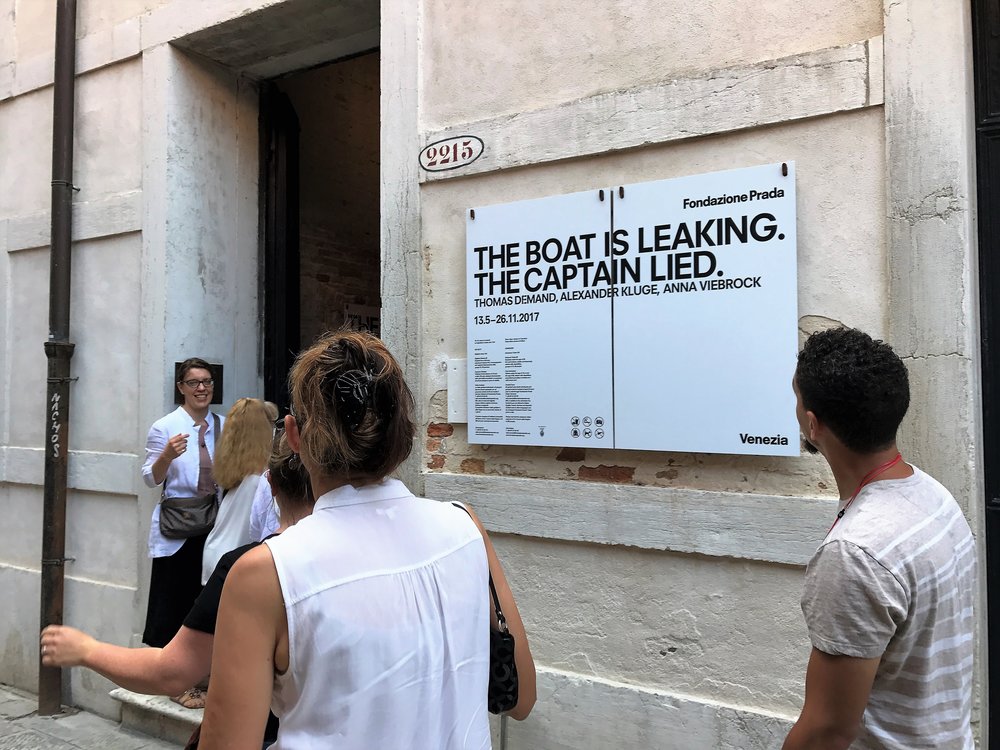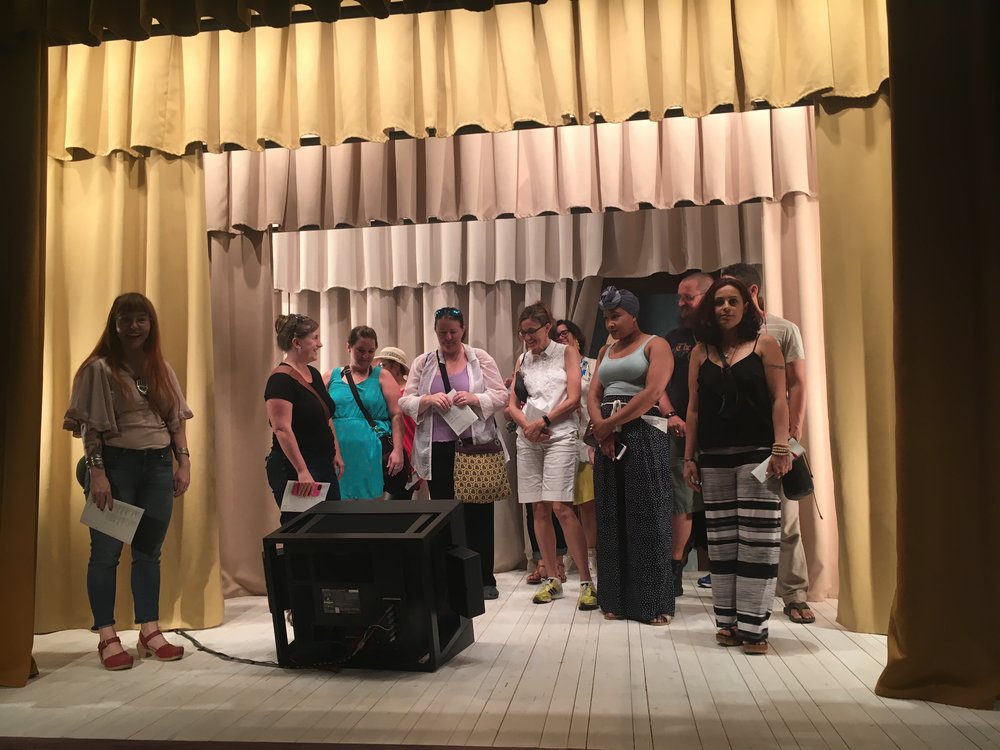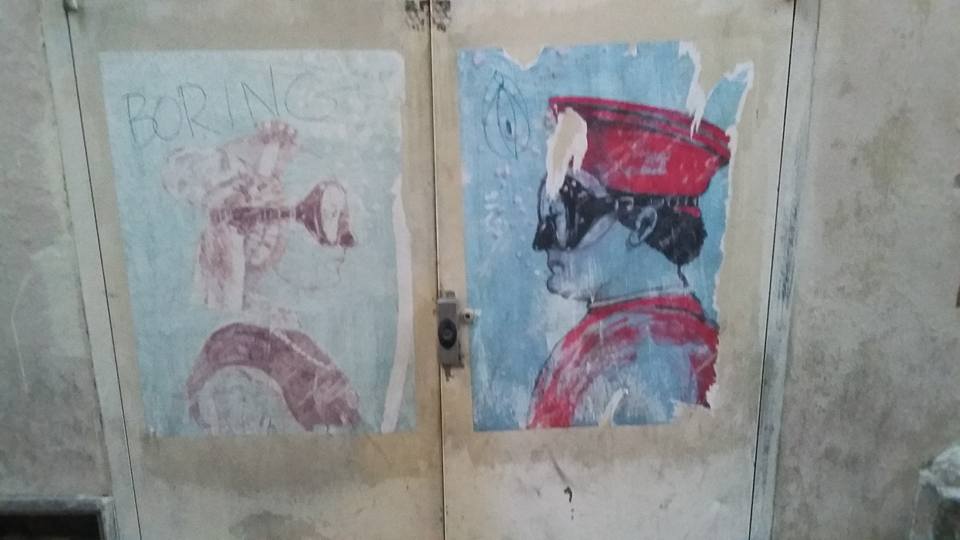Political Art or Artful Politics: Capitalistic Illusionary Undertones of Art Patrons
November 21, 2017
by Amy Jo Keely
The city of Venice, like other iconic cities of Europe, dances with the duality of modernity set within the framework of antiquity. The Peggy Guggenheim Collection, Punta della Dogana, and Prada Foundation express the dichotomies in Venice’s topological layering of political, historical, and artistic ideology within its architectural framework and art exhibits. The questions I ask are why are people so shocked about modern politics, and how does art via the Venice Biennale play into the global political discourse?
These questions take us back to Plato’s Republic in his Socratic dialogue about justice and government. Justice was also highlighted in Siena’s Palazzo Pubblico in the Sala della Pace in the fresco Allegory and Effects of Good and Bad Government by Ambrogio Lorenzetti. Florence and the capitalistic power of the Medici was balanced on the same scale of justice and government. Echoes of this dichotomy can also be heard in present-day Venice. We see it, for example, in the exhibits at the Guggenheim, Punta della Dogana, and the Prada Foundation. Set in Baroque period architecture, these contemporary art galleries are funded by billionaires – fashion house LVMH owner François Pinault, fashion house Prada, and the wealthy 19th century industrialist Guggenheim family. All are wealthy patrons of the arts yet their galleries charge entrance fees to the public.

While not commissioned for the wealthy, these works collected by the elite allow them to become patron-curators. But these three organizations, like the de Medicis, have cultivated art as an investment and public display of the power of wealth. These foundations were formed for corporate tax shield purposes, with the intent of providing a public service. They are designed to generate profits that are reinvested in programs, buildings, salaries, and expansion. One subtle difference, the Guggenheim Collection was Peggy’s privately curated collection of modern abstract art was housed in her home – in contrast to the traditional collection of her family – before being morphed into a public museum after her death.

[Photo 2 - The Prada Foundation’s Baroque building houses the exhibition of The Boat is Leaking. The Captain Has Lied, by filmmaker Alexander Kluge, artist Thomas Demand, stage and costume designer Anna Viebrock, and curator Udo Kittelmann. The building, Ca’ Corner della Regina, was completed in 1728 on the ruins of a Gothic building constructed in 1454 for the future queen of Cyprus. Great pains have been taken by the Prada Foundation to restore the building as well as the interior quintessentially Baroque frescoes. Yet built to mask the Baroque architecture – if not the ceilings – are freestanding structures that house a contemporary mixed media exhibit expounding a diatribe about the illusion and deception of modern politics. There is a pointed commentary on American politics – Trump in particular – with its photograph of folders on a table used at his news conference, most ironic in a country dealing with its own economic struggles and failing banks.
Why are people so dismayed about political games? Why are people decrying the end of the world? We are only destined to repeat history lest we forget the past as so evidentiary presented in the ancient writings of Plato, “And the same object appears straight when looked at out of the water, and crooked when in the water; and the concave becomes convex, owing to the illusion about colors to which the sight is liable. Thus every sort of confusion is revealed within us; and this is that weakness of the human mind on which the art of conjuring and deceiving by light and shadow and other ingenious devices imposes, having an effect upon us like magic.”

Many of the displayed works at the Biennale had political overtones, with commentaries on religion in the Italia Pavilion, on communism in the Russian Pavilion, on colonialism in the New Zealand Pavilion, and more. Unlike the political art of the Baroque period, street art within Rome’s Museum of Modern Art is recognized as political social protest now considered art. But it also exists in such a space curated graffiti with entrance fees versus the public graffiti freely displayed in every Italian city.
In conclusion, the topological relevance of Venice’s archeology and artistic political ideology informs our understanding of the works at the Biennale. Present-day Venice continues the legacy of of Siena and Florence through the lens of Plato. Historic buildings house modern art installations alongside baroque frescos and architecture. Venice carries forward ancient political discourses on justice through the curation of contemporary art for public exhibitions. The capitalistic utilization of art for power evidenced by the Medici’s continues in the not-for-profit La Biennale, LVMH billionaire François Pinault, and the Prada family who charge fees for tickets rather than being wholly funded by patrons. At its essence is Plato’s Socratic justice and Venice continues the discourse of art that exults civic pride as in Siena versus art to showcase power to the public similar to Florence.
